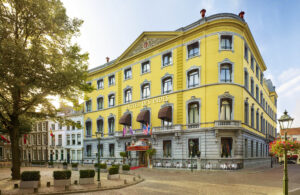
The Dutch city of The Hague has been in the news in recent weeks, as lawyers have descended on the Netherlands’ de facto capital to argue South Africa’s controversial case against the State of Israel.
We’re not here to talk law or politics, however, but rather about the city itself. Barely an hour by train from Amsterdam, The Hague is a city of immense charm; beautiful architecture; splendid government buildings; glorious trees (think of disease-free Dutch elms); super restaurants – many of them with a Malaysian, or Indonesian bent, reflecting Dutch colonial history; grand squares and avenues; and water, water everywhere. Add in warm, friendly people who speak better English than many native English speakers, and you start to get an idea of this underrated, utterly enchanting Northern European city.
Situated on the North Sea, which separates England from the Low Countries, The Hague has its own lake, Hofvijver, and even its own beach, at Scheveningen, a few minutes tram ride away from downtown. Mind your backs Sydney, Rio de Janeiro and Miami, because while The Hague may not be as warm or glamorous as those beachy hotspots, it is certainly a contender in summer.
As for where to stay, while there may be newer, trendier and swisher places in The Hague, there is still only one five-star hotel in the city, and that is the historic Hotel des Indes. Built in 1881, the hotel is a jewel, exuding a wonderful European atmosphere. With its imposing marble columns in the front lobby and reception rooms, the hotel is undeniably opulent, but on account of its compact size retains a kind of intimacy, more like a grand private house than a hotel. Marble staircases, period chandeliers and potted palms abound. Even the elevators here will amaze you, with their gold velvet panels studded with brass buttons.
Back in the 21st century, of course there is also a health club, in the basement, with excellent fitness and spa facilities.


Who hasn’t stayed at the des Indes? The Rolling Stones and U2 rocked here. The legendary courtesan, exotic dancer – and World War I German spy — Mata Hari did goodness knows what here. Ballerina Anna Pavlova hung up her toe shoes – that is to say, died – in the bedroom next to the hotel’s Japanese Salon. Twenty-sixth president Theodore Roosevelt Jr. was a guest – twice. He came first for the official opening of the Peace Palace, then known as the International Court of Arbitration, in 1902. Eight years later, he was back again. World leaders and international delegations – of which there are many – are still making Hotel des Indes their home in the city.
Speaking of Pavlova – the meringue dessert that was long held to have been invented for the ballet dancer by a chef Down Under, although that claim is now disputed – Hotel des Indes does a lavish high tea, with sandwiches, scones, pastries, meringues and cakes. In its first-floor restaurant, with its generously spaced tables and deeply comfortable chairs upholstered in red velvet, a typical dinner might comprise langoustines with shellfish mayonnaise and tobiko (roe) followed by venison with Champagne sauerkraut.
When I asked the concierge for a restaurant recommendation outside the hotel, somewhere specializing in Indonesian food, he pointed me in the direction of Poentjak, a few minutes’ walk away along one of The Hague’s most beautiful streets, Lange Voorhut. Here, the magnificent, mostly 18th-century embassy buildings stand side by side, a procession of flagpoles with their flags and polished brass door knockers.
In a building dating from the 1500s with carved wooden columns and brocade-clad walls, Poentjak doesn’t disappoint. A series of menus comprising upwards of 15 small plates will set you back somewhere in the region of $32 – a bargain in anybody’s book. In any other city, this historic restaurant would be a tourist trap. In The Hague it’s where locals eat and what they take for granted.


Other must-sees? The rather forbidding Peace Palace, also known as the International Court of Justice (ICJ); the Escher Museum, alongside Hotel des Indes – in a building that was the former palace of the Dutch Queen Mother Emma. It was closed after her death in 1934 and only reopened in 1945 for her daughter, Queen Wilhelmina, to receive Gen. Dwight D. Eisenhower. At the Mauritshuis Museum, you’ll find Johannes Vermeer’s 1665 oil painting “Girl With a Pearl Earring,” the inspiration for Tracy Chevalier’s novel and the 2003 film.
And don’t miss the Royal Library, the Royal Palace Gardens and the Binnenhof – home of the Dutch government. Check out the De Passage gallery mall while you’re out and about, dating from 1885, one of the oldest covered arcades in Europe and now a UNESCO World Heritage Site.
Last word? Look out for those cyclists. They’re everywhere – and seem to come at you from all sides. In The Hague, like other Dutch cities, the bicycle is king. You can hardly avoid them. Just make sure they avoid you.
For more, visit hoteldesindesthehague.com


















